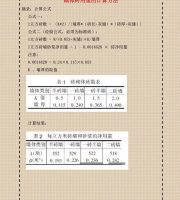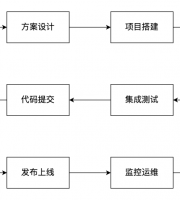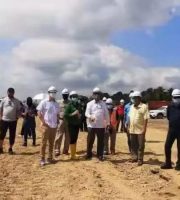The upper and lower reinforcement of the bottom plate shall be arranged according to the principle that the stressed reinforcement is outside.
3.
3.
Cushion block setting: cement mortar cushion blocks are placed at the lower part of the intersection of bottom reinforcement, with a spacing of 600mm, arranged in quincunx shape, and the additional reinforcement is carried out simultaneously with the slab reinforcement in sequence.
Spot welding along the center of the length of water stop steel plate according to the thickness of raft and the position of water stop φ 12 additional reinforcement, spacing 500mm.
The water stop steel plate groove shall face the upstream surface.
6.
After the concrete is transported to the site, the concrete slump shall be detected in time to verify the specific transportation time.
Concrete capping treatment: the final capping of concrete should be completed at the time of concrete water collection, and all poured concrete slab surfaces should be broomed in one direction to avoid surface cracks caused by premature capping.
2.
Temporary fences shall be set around to prevent sundries from entering.
2.
When the difference between the concrete surface temperature and the ambient temperature is less than 20 ℃, the temperature measurement can be stopped.
5.
6.
Plate reinforcement binding: all the intersections of the upper reinforcement mesh of the plate shall be bound, and the bottom reinforcement mesh can be bound alternately except the edge part.
The fabrication and spacing of the stirrup shall be determined according to the requirements.
5.
4.
Quality requirements: 1.
The pouring interval of upper and lower layers of concrete shall be strictly controlled to prevent construction cold joints.
5.
4.
The direction of the hook shall be correct.
4.
5.
5.
3.
3.
The setting and structure of mass concrete post cast strip and embedded parts must meet the design requirements, and leakage is strictly prohibited.
7.
The waterstop, water swelling waterstop, embedded waterstop and joint filling materials used for the post cast strip must meet the design requirements.
No person or material shall be stacked before the concrete strength reaches 1.2MPa.
The reinforcement of post cast strip must be derusted and positioned correctly.
Source: in case of infringement, please contact Zhulong forum to delete the mass concrete construction process flow: operation preparation → mixing and transportation of commercial concrete → concrete pouring → vibration → surface treatment → key points of maintenance operation: 1.
Construction preparation: the foundation reinforcement and formwork have been accepted, the surveyors have made elevation control lines, the concrete foreman has coordinated the commissioning of machines and tools, and the temperature measuring personnel have made the layout of temperature measuring points.
In order to ensure the construction quality of post cast strip concrete, the strength grade shall be increased by one level, and the variety and quantity of expansion agent shall be determined by the design.
The detailed construction of post cast strip, embedded parts and other parts must meet the design requirements, and leakage is strictly prohibited.
There shall be a written treatment plan or measures for the defects, and the treatment records shall be kept.
The concrete exceeding the initial setting time shall not be poured.
4.
The variety and quality of reinforcement must meet the design requirements and the provisions of relevant standards.
The binding joint shall comply with the provisions of the construction specification, and the overlapping length shall not be less than the relevant provisions of the design and atlas.
Concrete transportation: the concrete transportation must coordinate and control the continuity of concrete transportation in the mixing plant.
Construction process flow of foundation slab reinforcement binding: Surveying and setting out → binding elevator shaft and sump reinforcement → binding bottom slab reinforcement → placing cushion block → binding ground beam reinforcement → placing horse stool → laying professional pipeline → binding upper slab reinforcement → wall and column joint reinforcement → key points of concealed acceptance operation: 1.
Setting the stirrup: after the main and secondary beams of the foundation are inserted and fixed with the wall, column sump and other components, the stirrup shall be placed.
5.
3.
The mechanical performance results of reinforcement joints must comply with the special provisions on reinforcement connection construction and acceptance.
2.
Connect the additional reinforcement with the upper and lower reinforcement of the raft to fix the water stop steel plate.
The specification, shape, size, quantity, anchorage length and joint position of reinforcement must meet the design requirements and construction specifications.
Concrete pouring: the concrete pouring shall follow the principle of “from low to high and from far to near”, and the water and mortar shall be treated separately.
The temperature measurement data must be recorded in time once every 2h in the heating stage and once every 4H in the cooling stage.
All rebar joints shall be bound, and there shall be no missing or loose buckle.
Cut the steel wire mesh according to the position of the water stop steel plate and the thickness of the raft, and install the steel wire mesh at the upper and lower parts of the water stop steel plate.
Construction process flow of retaining post cast strip of foundation slab: concrete cushion construction → waterproof construction of foundation slab → construction of waterproof protective layer → binding of additional slab reinforcement (advanced water stop) → installation of additional slab rubber water stop and filling materials (advanced water stop) → concrete pouring of additional slab (advanced water stop) → binding of bottom plate reinforcement → welding and positioning of water stop steel plate → installation of water stop steel plate → installation and reinforcement of steel wire mesh and formwork of post cast strip → concrete pouring → roughening and cleaning of joint concrete surface and cleaning and protection of post cast strip → construction process of concrete pouring of post cast strip: 1.
3.
4.
The setting of temperature measuring points shall meet the requirements of gb50666-2011.
In the process of concrete pouring, the concrete bonded between the reinforcement and the formwork shall be cleaned in time.
The formwork of the post cast strip must be stable, sealed and flat, with sufficient strength, stiffness and stability to ensure the geometric dimension of the concrete.
2.
An additional waterproof coiled material is added to the post cast strip, and an empty coiled material is added to adjust the settlement deformation of the structure.
Quality requirements: 1.
The formwork shall be erected outside the steel wire mesh, the upper opening of the formwork shall be sawed out according to the spacing of reinforcement, the protective layer of reinforcement and the spacing of reinforcement shall be controlled, and the spacing of timbers for support and reinforcement shall not be greater than 500mm.
Concrete surface treatment: after the concrete is poured to the top surface, the cement slurry shall be removed in time, scraped preliminarily according to the elevation, leveled and compacted repeatedly with a wooden trowel, and the number of times of rubbing shall not be less than three.
4.
The concrete must be solid inside and smooth outside.
The waterstop shall be firmly fixed, straight and free from distortion..
After the concrete pouring on both sides of the post cast strip and the construction joint is completed, the post cast strip formwork shall be removed, and the concrete surface shall be carefully roughened until the stones are exposed, washed, and the sundries inside the post cast strip shall be cleaned manually and covered with plywood.
The concrete curing time shall not be less than 14d, and the concrete cooling rate shall not be greater than 2.0 ℃ / d.
The crack width on the surface of concrete structure shall not be greater than 0.2mm and shall not be penetrated.
2.
Mass concrete construction can be carried out in sections and layers according to the structural characteristics, and the treatment foundation part of the reserved construction joint adopts water stop steel plate, Effective measures such as retaining tensile anchor reinforcement shall be taken at the girder.
Temperature measurement and curing of concrete: temperature measurement shall be carried out immediately after the initial setting of concrete, and spacing measures shall be taken between the temperature measurement probe and the reinforcement.
Draw reinforcement position line: according to the reinforcement spacing indicated in the drawing, Calculate the actual number of reinforcement required for the bottom plate, clean the foundation waterproof protective layer on the bottom plate, and pop up the position lines of foundation main and secondary beam reinforcement, raft double-layer and two-way reinforcement, column reinforcement, wall reinforcement, sump and other component reinforcement with an ink bucket.
The steel wire at the adjacent binding points shall be buckled into a zigzag buckle to prevent the displacement of the overall reinforcement.
The surface of mass waterproof concrete structure shall be solid and flat without exposed reinforcement, honeycomb and other defects; The position of embedded parts shall be correct.
Quality requirements: 1.
2.
The compressive strength and impermeability pressure of mass concrete must meet the design requirements.
8.
9.
Concrete curing: concrete curing shall be carried out according to the temperature measurement data to ensure that the internal and external temperature difference does not exceed 25 ℃.
The raw materials, mix proportion and slump of mass concrete must meet the design requirements.
The concrete surface at the joint shall be dense, clean and dry.
Generally, water storage method is adopted to maintain and cover plastic film and straw bag.
The molding temperature of concrete shall not be greater than 30 ℃, and the maximum temperature rise of concrete pouring shall not be greater than 50 ℃.




